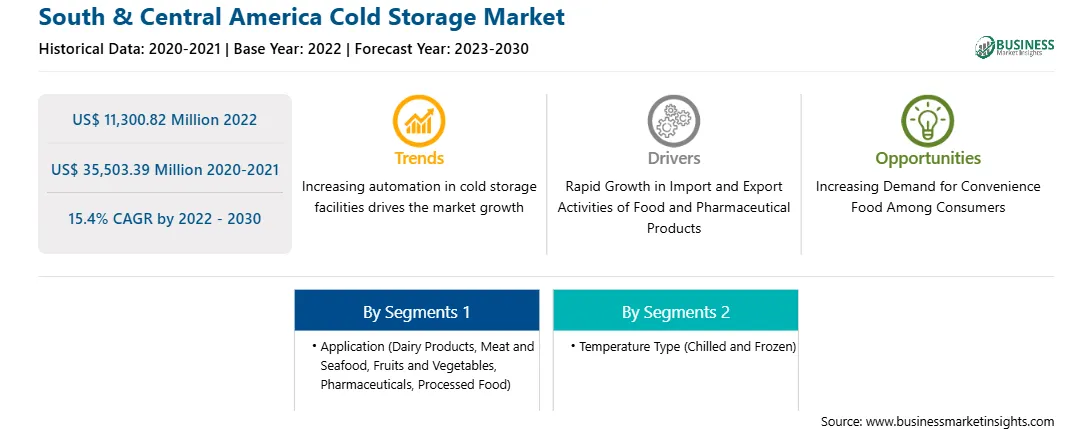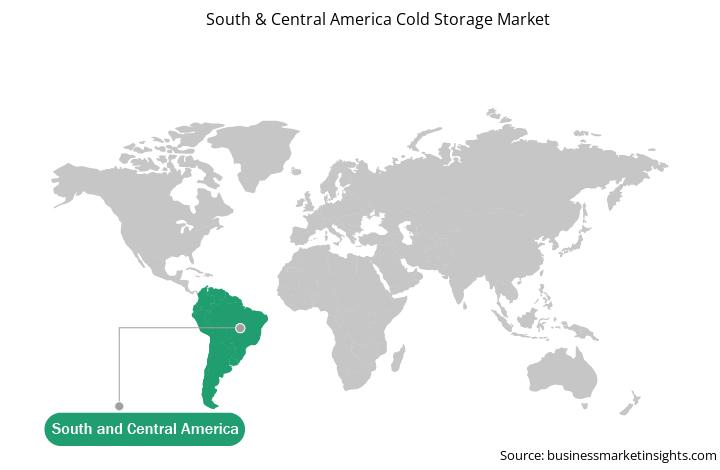The South & Central America cold storage market was valued at US$ 11,300.82 million in 2022 and is expected to reach US$ 35,503.39 million by 2030; it is estimated to register a CAGR of 15.4% from 2022 to 2030.
The application of transcritical CO2 systems uses carbon dioxide (CO2) as a refrigerant, which has a very low ozone depletion potential (ODP). Unlike conventional refrigerants such as hydrofluorocarbons (HFCs) or hydrochlorofluorocarbons (HCFCs), which contribute to ozone layer depletion, CO2 does not damage the ozone layer. This characteristic makes cold storage transcritical CO2 refrigeration systems environmentally friendly and supports global efforts to phase out ozone-depleting substances. Transcritical CO2 systems have a substantially minimalized global warming potential (GWP) compared to many conventional cold storage facilities. GWP measures the ability of greenhouse gases to impact global warming over a definite period. CO2 has a GWP of 1, whereas HFCs commonly used in refrigeration systems have GWPs in the thousands or even tens of thousands. By using CO2 as a refrigerant, transcritical systems help moderate climate change and reduce the carbon footprint of cooling and refrigeration applications. Overall, the low environmental impact of cold storage transcritical CO2 systems are driving the market by supporting global environmental objectives. As the need for sustainable refrigeration and storage solutions continues to develop, cold storage transcritical CO2 technology offers a viable and smart option for businesses across various sectors. Furthermore, the application of cold thermal storage technology is also one of the environment-friendly alternatives for storage facilities that can provide opportunities for the cold storage market over the forecast period.
The increasing population, rising consumer income, and growing preference for processed and canned food have positively favored the cold storage market. The popularity and importance of cold storage facilities have soared in recent years owing to increased expenditure on convenience and frozen food, probiotics, pharmaceuticals, or fresh produce. Several industries, such as food & beverages, pharmaceuticals, and chemicals, rely on cold storage facilities to preserve their products. In the food industry, the mounting demand for frozen and fresh foods has made cold storage facilities crucial for preserving product freshness and avoiding spoilage. The pharmaceutical industry immensely depends on cold storage to conserve the effectiveness of temperature-controlled vaccines and drugs.
Globalization and expansion in transport logistics have also boosted the supply chain of various products nationally or internationally. This trend has improved the demand for cold storage facilities to make certain that the products reach consumers in ideal condition, preserving a necessary temperature, regardless of distance and time of travel.
Brazil, Argentina, Peru, Chile, and Uruguay are the major contributors to the cold storage market in the South & Central American region. Increasing per capita income, changing consumer food preferences, and busy lifestyles are the major factors boosting the demand for processed meat, fruits, vegetables, seafood, and fish products in South & Central America.
Strategic insights for the South & Central America Cold Storage provides data-driven analysis of the industry landscape, including current trends, key players, and regional nuances. These insights offer actionable recommendations, enabling readers to differentiate themselves from competitors by identifying untapped segments or developing unique value propositions. Leveraging data analytics, these insights help industry players anticipate the market shifts, whether investors, manufacturers, or other stakeholders. A future-oriented perspective is essential, helping stakeholders anticipate market shifts and position themselves for long-term success in this dynamic region. Ultimately, effective strategic insights empower readers to make informed decisions that drive profitability and achieve their business objectives within the market.

| Report Attribute | Details |
|---|---|
| Market size in 2022 | US$ 11,300.82 Million |
| Market Size by 2030 | US$ 35,503.39 Million |
| Global CAGR (2022 - 2030) | 15.4% |
| Historical Data | 2020-2021 |
| Forecast period | 2023-2030 |
| Segments Covered |
By Application
|
| Regions and Countries Covered | South and Central America
|
| Market leaders and key company profiles |
The geographic scope of the South & Central America Cold Storage refers to the specific areas in which a business operates and competes. Understanding local distinctions, such as diverse consumer preferences (e.g., demand for specific plug types or battery backup durations), varying economic conditions, and regulatory environments, is crucial for tailoring strategies to specific markets. Businesses can expand their reach by identifying underserved areas or adapting their offerings to meet local demands. A clear market focus allows for more effective resource allocation, targeted marketing campaigns, and better positioning against local competitors, ultimately driving growth in those targeted areas.

The South & Central America cold storage market is categorized into application, temperature type, warehouse type, and country.
Based on application, the South & Central America cold storage market is segmented into dairy products, meat and seafood, fruits and vegetables, pharmaceuticals, and processed food. The meat and seafood segment held the largest South & Central America cold storage market share in 2022.
In terms of temperature type, the South & Central America cold storage market is bifurcated into chilled and frozen. The frozen segment held a larger South & Central America cold storage market share in 2022.
By warehouse type, the South & Central America cold storage market is segmented into public and private & semi-private. The public segment held a larger South & Central America cold storage market share in 2022.
By country, the South & Central America cold storage market is segmented into Brazil, Argentina, and the Rest of South & Central America. Brazil dominated the South & Central America cold storage market share in 2022.
SuperFrio Armazens Gerais SA, Frialsa Frigorificos SA de CV, Friozem Armazens Frigoreticos Ltda, Emergent Cold LatAm Management LLC, and Americold Realty Trust Inc, are some of the leading companies operating in the South & Central America cold storage market.
The South & Central America Cold Storage Market is valued at US$ 11,300.82 Million in 2022, it is projected to reach US$ 35,503.39 Million by 2030.
As per our report South & Central America Cold Storage Market, the market size is valued at US$ 11,300.82 Million in 2022, projecting it to reach US$ 35,503.39 Million by 2030. This translates to a CAGR of approximately 15.4% during the forecast period.
The South & Central America Cold Storage Market report typically cover these key segments-
The historic period, base year, and forecast period can vary slightly depending on the specific market research report. However, for the South & Central America Cold Storage Market report:
The South & Central America Cold Storage Market is populated by several key players, each contributing to its growth and innovation. Some of the major players include:
The South & Central America Cold Storage Market report is valuable for diverse stakeholders, including:
Essentially, anyone involved in or considering involvement in the South & Central America Cold Storage Market value chain can benefit from the information contained in a comprehensive market report.